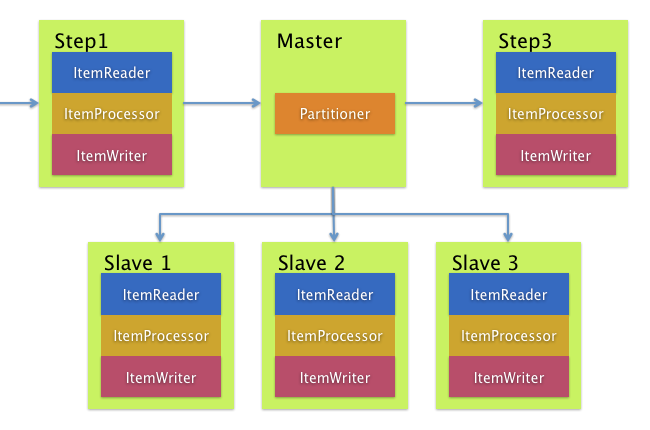您好,登錄后才能下訂單哦!
您好,登錄后才能下訂單哦!
spring batch中基于RabbitMQ遠程分區Step是怎樣的,相信很多沒有經驗的人對此束手無策,為此本文總結了問題出現的原因和解決方法,通過這篇文章希望你能解決這個問題。
前言碎語
小編構建的實例可為主服務,從服務,主從混用等模式,可以大大提高spring batch在單機處理時的時效。
項目源碼:https://gitee.com/kailing/partitionjob
spring batch遠程分區Step的原理
master節點將數據根據相關邏輯(ID,hash),拆分成一段一段要處理的數據集,然后將數據集放到消息中間件中(ActiveMQ,RabbitMQ ),從節點監聽到消息,獲取消息,讀取消息中的數據集處理并發回結果。如下圖:

下面按原理分步驟實施,完成spring batch的遠程分區實例
第一步,首先引入相關依賴
見:https://gitee.com/kailing/partitionjob/blob/master/pom.xml
分區job主要依賴為:spring-batch-integration,提供了遠程通訊的能力
第二步,Master節點數據分發
@Profile({"master", "mixed"})
@Bean
public Job job(@Qualifier("masterStep") Step masterStep) {
return jobBuilderFactory.get("endOfDayjob")
.start(masterStep)
.incrementer(new BatchIncrementer())
.listener(new JobListener())
.build();
}
@Bean("masterStep")
public Step masterStep(@Qualifier("slaveStep") Step slaveStep,
PartitionHandler partitionHandler,
DataSource dataSource) {
return stepBuilderFactory.get("masterStep")
.partitioner(slaveStep.getName(), new ColumnRangePartitioner(dataSource))
.step(slaveStep)
.partitionHandler(partitionHandler)
.build();
}master節點關鍵部分是,他的Step需要設置從節點Step的Name,和一個數據分區器,數據分區器需要實現Partitioner接口,它返回一個Map<String, ExecutionContext>的數據結構,這個結構完整的描述了每個從節點需要處理的分區片段。ExecutionContext保存了從節點要處理的數據邊界,當然,ExecutionContext里的參數是根據你的業務來的,我這里,已數據ID為邊界劃分了每個區。具體的Partitioner實現如下:
/**
* Created by kl on 2018/3/1.
* Content :根據數據ID分片
*/
public class ColumnRangePartitioner implements Partitioner {
private JdbcOperations jdbcTemplate;
ColumnRangePartitioner(DataSource dataSource){
this.jdbcTemplate = new JdbcTemplate(dataSource);
}
@Override
public Map<String, ExecutionContext> partition(int gridSize) {
int min = jdbcTemplate.queryForObject("SELECT MIN(arcid) from kl_article", Integer.class);
int max = jdbcTemplate.queryForObject("SELECT MAX(arcid) from kl_article", Integer.class);
int targetSize = (max - min) / gridSize + 1;
Map<String, ExecutionContext> result = new HashMap<String, ExecutionContext>();
int number = 0;
int start = min;
int end = start + targetSize - 1;
while (start <= max) {
ExecutionContext value = new ExecutionContext();
result.put("partition" + number, value);
if (end >= max) {
end = max;
}
value.putInt("minValue", start);
value.putInt("maxValue", end);
start += targetSize;
end += targetSize;
number++;
}
return result;
}
}第三步,Integration配置
spring batch Integration提供了遠程分區通訊能力,Spring Integration擁有豐富的通道適配器(例如JMS和AMQP),基于ActiveMQ,RabbitMQ等中間件都可以實現遠程分區處理。本文使用RabbitMQ來做為通訊的中間件。關于RabbitMQ的安裝等不在本篇范圍,下面代碼描述了如何配置MQ連接,以及spring batch分區相關隊列,消息適配器等。
/**
* Created by kl on 2018/3/1.
* Content :遠程分區通訊
*/
@Configuration
@ConfigurationProperties(prefix = "spring.rabbit")
public class IntegrationConfiguration {
private String host;
private Integer port=5672;
private String username;
private String password;
private String virtualHost;
private int connRecvThreads=5;
private int channelCacheSize=10;
@Bean
public ConnectionFactory connectionFactory() {
CachingConnectionFactory connectionFactory = new CachingConnectionFactory(host, port);
connectionFactory.setUsername(username);
connectionFactory.setPassword(password);
connectionFactory.setVirtualHost(virtualHost);
ThreadPoolTaskExecutor executor = new ThreadPoolTaskExecutor();
executor.setCorePoolSize(connRecvThreads);
executor.initialize();
connectionFactory.setExecutor(executor);
connectionFactory.setPublisherConfirms(true);
connectionFactory.setChannelCacheSize(channelCacheSize);
return connectionFactory;
}
@Bean
public MessagingTemplate messageTemplate() {
MessagingTemplate messagingTemplate = new MessagingTemplate(outboundRequests());
messagingTemplate.setReceiveTimeout(60000000l);
return messagingTemplate;
}
@Bean
public DirectChannel outboundRequests() {
return new DirectChannel();
}
@Bean
@ServiceActivator(inputChannel = "outboundRequests")
public AmqpOutboundEndpoint amqpOutboundEndpoint(AmqpTemplate template) {
AmqpOutboundEndpoint endpoint = new AmqpOutboundEndpoint(template);
endpoint.setExpectReply(true);
endpoint.setOutputChannel(inboundRequests());
endpoint.setRoutingKey("partition.requests");
return endpoint;
}
@Bean
public Queue requestQueue() {
return new Queue("partition.requests", false);
}
@Bean
@Profile({"slave","mixed"})
public AmqpInboundChannelAdapter inbound(SimpleMessageListenerContainer listenerContainer) {
AmqpInboundChannelAdapter adapter = new AmqpInboundChannelAdapter(listenerContainer);
adapter.setOutputChannel(inboundRequests());
adapter.afterPropertiesSet();
return adapter;
}
@Bean
public SimpleMessageListenerContainer container(ConnectionFactory connectionFactory) {
SimpleMessageListenerContainer container = new SimpleMessageListenerContainer(connectionFactory);
container.setQueueNames("partition.requests");
container.setAutoStartup(false);
return container;
}
@Bean
public PollableChannel outboundStaging() {
return new NullChannel();
}
@Bean
public QueueChannel inboundRequests() {
return new QueueChannel();
}第四步,從節點接收分區信息并處理
@Bean
@Profile({"slave","mixed"})
@ServiceActivator(inputChannel = "inboundRequests", outputChannel = "outboundStaging")
public StepExecutionRequestHandler stepExecutionRequestHandler() {
StepExecutionRequestHandler stepExecutionRequestHandler = new StepExecutionRequestHandler();
BeanFactoryStepLocator stepLocator = new BeanFactoryStepLocator();
stepLocator.setBeanFactory(this.applicationContext);
stepExecutionRequestHandler.setStepLocator(stepLocator);
stepExecutionRequestHandler.setJobExplorer(this.jobExplorer);
return stepExecutionRequestHandler;
}
@Bean("slaveStep")
public Step slaveStep(MyProcessorItem processorItem,
JpaPagingItemReader reader) {
CompositeItemProcessor itemProcessor = new CompositeItemProcessor();
List<ItemProcessor> processorList = new ArrayList<>();
processorList.add(processorItem);
itemProcessor.setDelegates(processorList);
return stepBuilderFactory.get("slaveStep")
.<Article, Article>chunk(1000)//事務提交批次
.reader(reader)
.processor(itemProcessor)
.writer(new PrintWriterItem())
.build();
}從節點最關鍵的地方在于StepExecutionRequestHandler,他會接收MQ消息中間件中的消息,并從分區信息中獲取到需要處理的數據邊界,如下ItemReader:
@Bean(destroyMethod = "")
@StepScope
public JpaPagingItemReader<Article> jpaPagingItemReader(
@Value("#{stepExecutionContext['minValue']}") Long minValue,
@Value("#{stepExecutionContext['maxValue']}") Long maxValue) {
System.err.println("接收到分片參數["+minValue+"->"+maxValue+"]");
JpaPagingItemReader<Article> reader = new JpaPagingItemReader<>();
JpaNativeQueryProvider queryProvider = new JpaNativeQueryProvider<>();
String sql = "select * from kl_article where arcid >= :minValue and arcid <= :maxValue";
queryProvider.setSqlQuery(sql);
queryProvider.setEntityClass(Article.class);
reader.setQueryProvider(queryProvider);
Map queryParames= new HashMap();
queryParames.put("minValue",minValue);
queryParames.put("maxValue",maxValue);
reader.setParameterValues(queryParames);
reader.setEntityManagerFactory(entityManagerFactory);
return reader;
}中的minValuemin,maxValue,正是前文中Master節點分區中設置的值
如上,已經完成了整個spring batch 遠程分區處理的實例,需要注意的是,一個實例,即可主可從可主從,是有spring profile來控制的,細心的人可能會發現@Profile({"master", "mixed"})等注解,所以如果你在測試的時候,別忘了在spring boot中配置好spring.profiles.active=slave等。
看完上述內容,你們掌握spring batch中基于RabbitMQ遠程分區Step是怎樣的的方法了嗎?如果還想學到更多技能或想了解更多相關內容,歡迎關注億速云行業資訊頻道,感謝各位的閱讀!
免責聲明:本站發布的內容(圖片、視頻和文字)以原創、轉載和分享為主,文章觀點不代表本網站立場,如果涉及侵權請聯系站長郵箱:is@yisu.com進行舉報,并提供相關證據,一經查實,將立刻刪除涉嫌侵權內容。